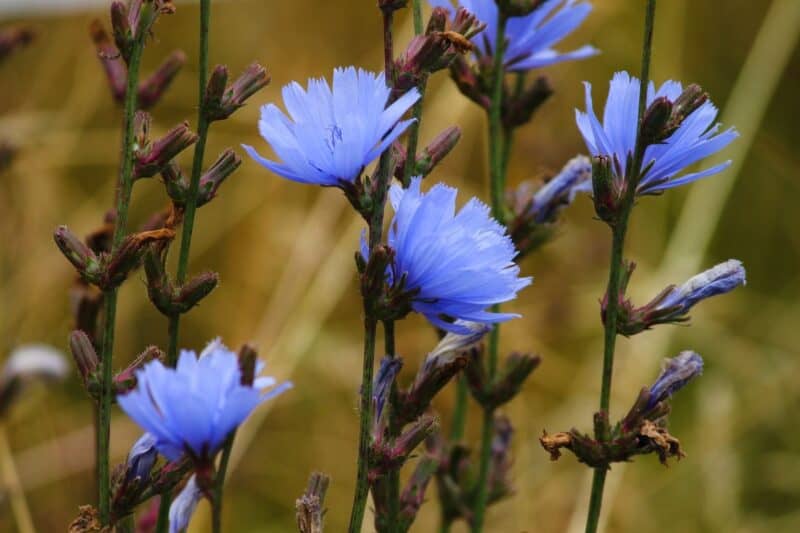Chicory plants are often foraged in most regions of the United States as a wild edible and medicinal. But, if they do not happen to grow where you live because of either the climate or urban environment – or simply because you want more chicory plant than you can find, it is quite feasible to cultivate this hardy and beautiful plant at home.

It might take a bit of searching to find chicory plant seeds, they are surely not as common at the local gardening center as many plant. You can find chicory plant seeds online from garden retailers or Amazon.
Although chicory was once regularly cultivated in gardens alongside vegetables still common today, it is now primarily grown by herbalist and farmers. Chicory makes a nutrient rich, easy to grow fodder for mosts types of livestock.
Chicory plants are a woody perennial that are available in multiple varieties. It is in the same plant family as sunflowers, dandelions, yarrow, lettuce, chrysanthemums, artichokes, and dahlias. The plant is most often cultivated for its roots and leaves. Because of its deep taproot and love for tightly compacted soil, chicory is a highly drought tolerant plant.
Chicory Nutritional Value
From a nutritional standpoint, a chicory plant is a powerhouse. It contains more polyphenols than spinach. A single cup of chicory possesses 235mg of polyphenols – that the number found in Popeye’s favorite muscle building treat.
This naturally occurring compound can help reduce swelling, promote cardiovascular system protection (among other things).
As noted by the United States Department of Agriculture National Nutrient Database, chicory boasts significant amounts of zinc, potassium, manganese, iron, vitamins A, B6, C, E, K, and folic acid.
Even though Chicory has a bitter taste, when it is used in baking and cooking recipes that also include sugar, it may increase the sweetness of the sugar or stevia about 100 times its normal taste.
How to Grow Chicory Plants
- Plant chicory seeds about 1 inch deep in the soil.
- The seeds should be sown directly into the dirt approximately 14 to 21 days before the expected last hard frost. In many parts of the United States, the best time to start chicory seeds is from the middle of March through the early days of May.
- Plant the seeds about 1 foot to 18 inches apart.
- For best results, plant the seeds in well-draining soil that is rich in natural organic matter to help its long taproot grow long and hardy.
Chicory Growing Tips
There are two ways to grow a chicory plant – forced and non-forced. The forcing process is rather lengthy and requires the digging up of the taproots from the plant during the winter and storing them in sand.
About four weeks after being stored in sand, a chicon will have emerged and be ready for harvesting. You snap the chicon free from the taproot and leaves the rest of the root in the sand to spawn another crop of chicons.
Non-Forced Cultivation
- The seeds must have time to get started before the temperature gets too hot – and after it is too chilly. Being subjected to only a light frost might help ward off some of the bitter taste that is often associated with the plant – adding a tiny bit of sweetness in the process.
- Growing chicory plants is fairly similar to cultivating other types of greens. The plant thrives the most when exposed to temperatures that range between 45 F to 75 F (7C to 23 C).
- As already noted, chicory might not be too picky about the soil type it is planted in, but making sure the soil drains well and the area around the plant is weeded diligently, will most often foster a better harvest.
- Mulch around the plant to help it retain moisture during times of drought.
- While fertilizer is not really necessary to get a chicory plant to grow, using a nitrogen based fertilizer to ensure the proper pH balance is created and maintained, is highly recommended.
Pests and Disease
Even though chicory plants tend to be exceptionally hardy, some common pests and diseases can still wipe out your growing crop.
Diseases
- Bottom Rot
- Fusarium Wilt
- Dampening Off Disease
- Downy Mildews
- Anthracnose
- Septoria Blight
- Bacterial Soft Rot
- White Mold
Pests
- Thrips
- Darkling Beetles
- Aphids
- Slugs
- Cabbage Loopers
- Leaf Miners
- Snails
- Flea Beetles
Snails and slugs are often the biggest pests to plague chicory plants.These harmful insects cut irregular cuts or holes into both the stems and the leaves of the chicory plant. Sometimes snails and slugs even cause damage to the flowers of a chicory plant.
During a particularly bad slug or snail infestation, slime develops across the plant leaves, and the individual leaves are sometimes shredded, as well. To deter snails and slugs from getting near your chicory plants, sprinkle wood ash and – or cracked eggshells around the perimeter of the plant.
The wood ash sucks the moisture from the insects, and the eggshells scratch their soft underbelly in a manner that is uncomfortable enough to often get them to reroute the path of their feeding frenzy.
Saving the seeds from wild chicory plants to cultivate is often done with moderate levels of success. There are several varieties of domesticated chicory that you will probably have far more success with when planting in a raised bed or pots.
- Brussels Witloof – This variety of chicory is primarily grown for root harvesting or “root forcing” cultivation. It takes about 80 days to harvest this plant when grown from seed.
- Magdeburg – It takes about 100 days from seed sowing to harvesting. This type of chicory is also often grown for its root and is frequently used as a coffee substitute.
- Chioggia – this breed of the plant is known for its large and more rounded head. The flowers on chioggia are more pink to red in color. But, the flower heads can also produce white to reddish and greenish to yellow flowers. It takes only 67 from seed sowing to harvesting.
- Witloof Zoom – This is a sugarloaf variety of chicory that is grown for its root. It takes approximately140 days to harvest. Although grown for its root primarily, Witloof Zoom spawns top quality leaves that taste great in salad, and when blanched to use in various recipes.
It is possible to cultivate chicory inside during the winter months, but you must allow the plant to be exposed to a grow light or a window that gets considerable light and heat. The plants tend to grow in bush fashion, so using a three to five gallon pot is highly recommended.


Tara lives on a 56 acres farm in the Appalachian Mountains, where she faces homesteading and farming challenges every single day, raising chickens, goats, horses, and tons of vegetables. She’s an expert in all sorts of homesteading skills such as hide tanning, doll making, tree tapping, and many more.
